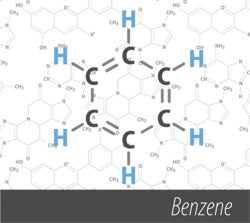This is a factsheet about a chemical that may be found in some public or private drinking water supplies. It may cause health problems if found in amounts greater than the health standard set by the United States Environmental Protection Agency (EPA).
What is Benzene and how is it used?
Benzene is a clear, colorless aromatic liquid. It is highly flammable. The greatest use of benzene is as a building block for making plastics, rubber, resins, and synthetic fabrics like nylon and polyester. Other uses include: as a solvent in printing, paints, dry cleaning, etc.?
The list of trade names given below may help you find out whether you are using this chemical at home or work.
Trade Names and Synonyms:
- Benzol 90
- Pyrobenzol
- Polystream
- Coal naphtha
- Phene

Why is Benzene being Regulated?
In 1974, Congress passed the Safe Drinking Water Act. This law requires EPA to determine safe levels of chemicals in drinking water that do or may cause health problems. These non-enforceable levels, based solely on possible health risks and exposure, are called Maximum Contaminant Level Goals.
The MCLG for benzene has been set at zero because EPA believes this level of protection would not cause any of the health effects described below.
Based on this MCLG, EPA has set an enforceable standard called a Maximum Contaminant Level (MCL). MCLs are set as close to the MCLGs as possible, considering the ability of public water systems to detect and remove contaminants using suitable treatment technologies.
The MCL has been set at 5 parts per billion (ppb) because EPA believes, given present technology and resources, this is the lowest level to which water systems can reasonably be required to remove this contaminant should it occur in drinking water.
These drinking water standards and the regulations for ensuring these standards are met, are called National Primary Drinking Water Regulations. All community water supplies must abide by these regulations.
What are the Health Effects?
Short-term: EPA has found benzene to potentially cause the following health effects when people are exposed to it at levels above the MCL for relatively short periods of time: temporary nervous system disorders, immune system depression, anemia.
Long-term: Benzene has the potential to cause the following effects from a lifetime exposure at levels above the MCL: chromosome aberrations, cancer.
How much Benzene is produced and released to the environment?
Production of benzene has increased: from about 9.9 billion lbs. in 1984 to over 12 billion lbs. in 1993.
Benzene is released to air primarily from fumes and exhaust connected with its use in gasoline. Other sources are fumes from its production and use in manufacturing other chemicals. In addition, there are discharges into the water from industrial effluents and losses during spills.
From 1987 to 1992, according to the Toxics Release Inventory, releases of benzene to water and land totaled over 2 million lbs. These releases were primarily from petroleum refining industries, with the greatest releases occurring in Texas.
What happens to Benzene when it is released to the environment?
If benzene is released to soil, it will either evaporate very quickly or leach to groundwater. It can be broken down by some soil microbes. It may also be degraded in some groundwaters. If benzene is released to surface water, most of it should evaporate within a few hours. Though it does not degrade by reacting with water, it may be degraded by microbes. It is not likely to accumulate in aquatic organisms.
How will Benzene be Detected in and Removed from My Drinking Water?
The regulation for benzene became effective in 1989. Between 1993 and 1995, EPA required your water supplier to collect water samples every 3 months for one year and analyze them to find out if benzene is present above 0.5 ppb. If it is present above this level, the system must continue to monitor the benzene levels.
If contaminant levels are found to be consistently above the MCL, your water supplier must take steps to reduce the amount of benzene so that it is consistently below that level. The following treatment methods have been approved by EPA for removing benzene: Granular activated charcoal in combination with Packed Tower Aeration.
How will I know if Benzene is in my drinking water?
If the levels of benzene exceed the MCL, 5 ppb, the system must notify the public via newspapers, radio, TV, and other means. Additional actions, such as providing alternative drinking water supplies, may be required to prevent serious risks to public health.
Drinking Water Standards:
- Mclg: zero
- Mcl: 5 ppb
Benzene Releases to Water and Land, 1987 to 1993 (in pounds):
| Water | Land | |
|---|---|---|
| TOTAL | 564,546 | 1,539,385 |
| Top Six States* | ||
|---|---|---|
| TX | 1,436 | 1,135,994 |
| AL | 199,642 | 0 |
| LA | 137,599 | 4,347 |
| CO | 0 | 40,793 |
| NM | 0 | 38,199 |
| IL | 3 | 34,110 |
| Major Industries* | ||
|---|---|---|
| Petroleum refining | 32,411 | 1,049,800 |
| Primary Metal Ind. | 133,339 | 18,078 |
| Industrial chemicals | 73,000 | 250,103 |
| Alkalies, chlorine | 122,240 | 0 |
* Water/Land totals only include facilities with releases greater than a certain amount - usually 1000 to 10,000 lbs.
As
part of the Drinking Water and Health pages, this fact sheet is part of a larger
U.S. EPA publication:
EPA National Primary Drinking Water Regulations



